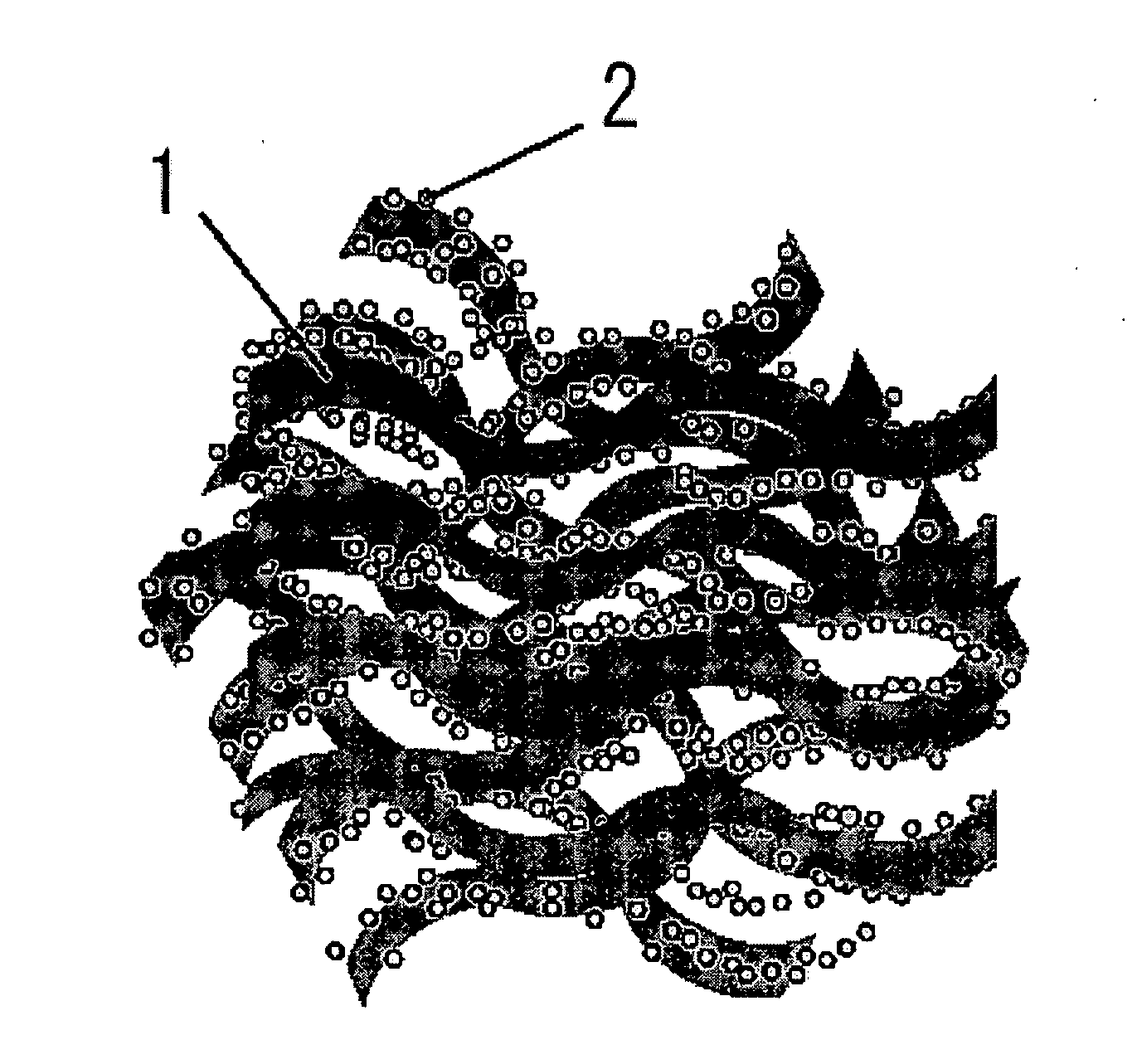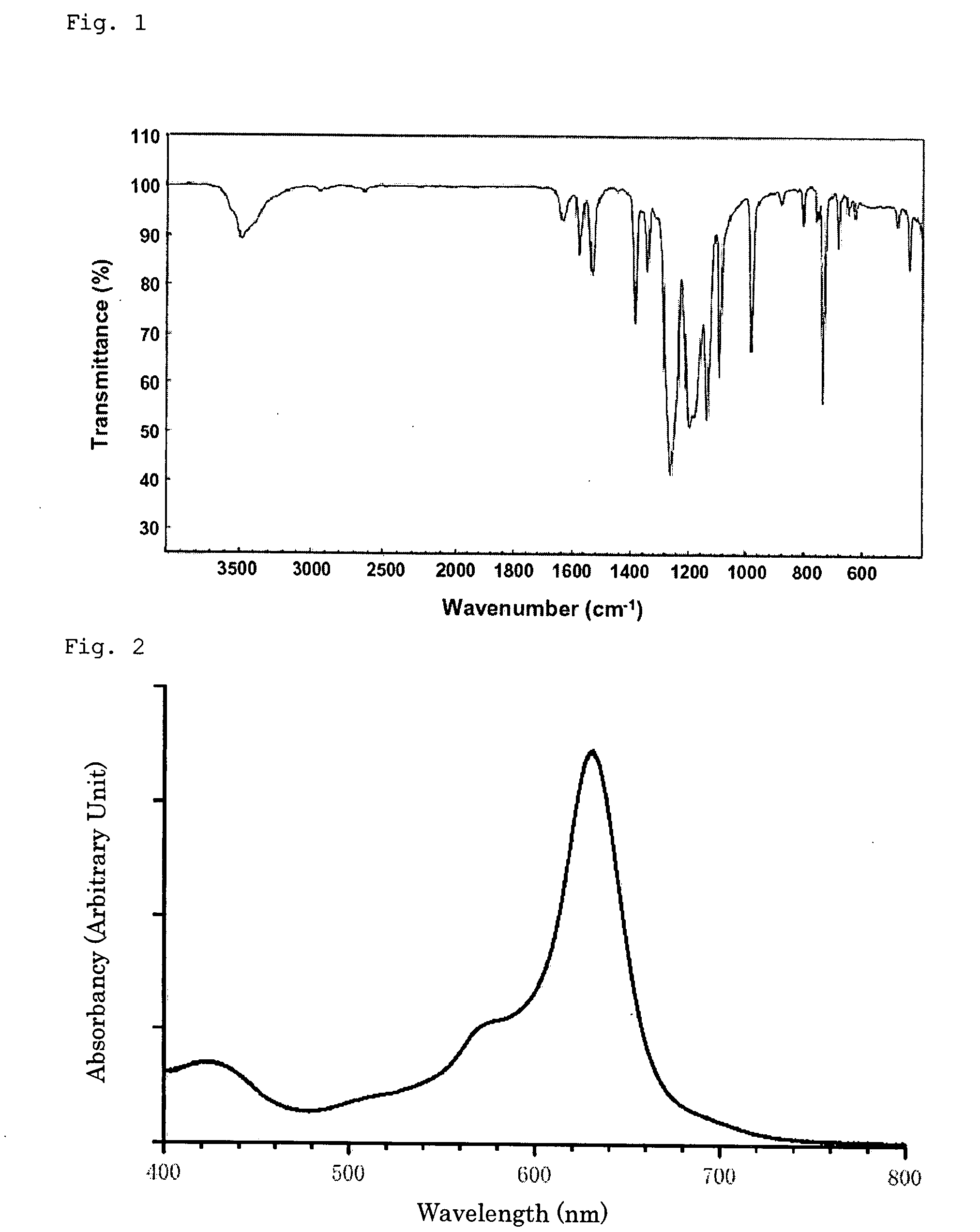Electrode for use in oxygen reduction
a technology of electrodes and electrodes, applied in the direction of electrochemical generators, cell components, physical/chemical process catalysts, etc., can solve problems such as metal complexes, and achieve the effect of high valen
- Summary
- Abstract
- Description
- Claims
- Application Information
AI Technical Summary
Benefits of technology
Problems solved by technology
Method used
Image
Examples
synthetic example 1
Synthesizing the Derivative of the Present Invention: CoPyrz(CF3)8
[0127] 2,3-bis(trifluoromethyl)-5,6-dicyanopyrazine (2.66 g), 0.49 g of cobalt (II) acetate and 8.0 g of anhydrous sodium sulfate were mixed.
[0128] The resultant mixture was heated from room temperature to 200° C. over 45 minutes using an oil bath. During heating, the reaction started around 120° C. and the reaction system gradually became purple. After being kept at 200° C. for 30 minutes, the mixture was cooled to room temperature.
[0129] The reaction mixture was washed with water and dried after removing anhydrous sodium sulfate and / or acetic acid, giving 2.55 g of coarse derivative of the present invention (purple black powder).
[0130] The resultant coarse derivative was purified using column chromatography (stationary phase: silica gel, mobile phase: tetrahydrofuran). The result of quantitative analysis for cobalt in the purified derivative of the present invention (purple black powder) was 5.5%, which falls wi...
example 1
(Preparation of Example Electrodes 1 to 6, and Comparative Example Electrodes 101 to 112)
[0134] Example electrodes 1 and 4, and Comparative Example electrodes 101, 104, 107, and 110 have the cross-sectional structure shown in FIG. 7A. Numerical symbols 4, 6 and 7 in FIG. 7A are as explained below.
[0135] Numerical symbol 4 is a GC electrode or Au electrode. The GC electrode or Au electrode is a pellet having a thickness of 5 mm and diameter of 6 mm. An electrode lead wire 7 is connected to one surface of the electrode pellet, and a catalyst is supported on the other surface. The electrode pellet and the electrode lead wire are accommodated in a polyimide resin sheathing 6 having a diameter of 10 mm and a length of 80 mm. The same explanations of numerical symbols 4, 6, and 7 can also be applied to FIGS. 7B to 7D.
[0136] Numerical symbol 5 in FIG. 7A is an oxygen-reducing catalyst.
[0137] Example electrodes 2, 3, 5 and 6, and Comparative Example electrodes 102, 103, 105, 106, 108, ...
example 2
(Preparation of Example Electrodes 7 to 12, and Comparative Example Electrodes 113 to 124)
[0151] Example electrodes 7 and 10, and Comparative Example electrodes 113, 116, 119, and 123 have the cross-sectional structure shown in FIG. 7B.
[0152] In FIG. 7B, numerical symbol 8 is a Nafion membrane containing MnOx.
[0153] Example electrodes 8, 9, 11 and 12, and Comparative Example electrodes 114, 115, 117, 118, 120, 121, 123 and 124 have the cross-sectional structure shown in FIG. 7D.
[0154] In FIG. 7D, numerical symbol 10 is an oxygen-reducing catalyst supported on a conductive substrate together with MnOx and Nafion (product of Du Pont, product name: Nafion 117).
[0155] Table 2 shows the catalyst, carrier (including electrode pellet), etc., used in each oxygen-reducing electrode.
[0156] In each oxygen-reducing electrode, the catalyst was supported by a wet process. The details of the wet process are as below.
[0157] First, an oxygen-reducing catalyst was supported in the same manner...
PUM
| Property | Measurement | Unit |
|---|---|---|
| Acidity | aaaaa | aaaaa |
| Electric potential / voltage | aaaaa | aaaaa |
| Electric potential / voltage | aaaaa | aaaaa |
Abstract
Description
Claims
Application Information
 Login to View More
Login to View More - R&D
- Intellectual Property
- Life Sciences
- Materials
- Tech Scout
- Unparalleled Data Quality
- Higher Quality Content
- 60% Fewer Hallucinations
Browse by: Latest US Patents, China's latest patents, Technical Efficacy Thesaurus, Application Domain, Technology Topic, Popular Technical Reports.
© 2025 PatSnap. All rights reserved.Legal|Privacy policy|Modern Slavery Act Transparency Statement|Sitemap|About US| Contact US: help@patsnap.com



